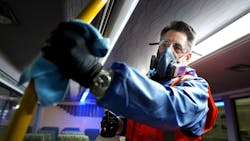More frequent cleaning, additional educational outreach and task forces among steps North American transit agencies are taking to fight spread of coronavirus
Public transportation providers across North America this week have outlined a series of precautions they are taking to help combat the spread of COVID-19, also known as the coronavirus. As of March 3, the United States had 60 cases in 12 states and Canada had 33 cases in three provinces.
While the Centers for Disease Control outlines common sense precautions such as not touching your face, eyes and nose, washing your hands and using hand sanitizer, the close confines and high-touch surfaces found on mass transit systems could be problematic to limiting the spread of the virus. For example, on Feb. 29, the Regional Municipality of York, Ontario, near Toronto, cautioned residents that a woman who recently returned from a trip to Iran was known to have ridden a GO Bus from Toronto Pearson Airport to Richmond Hill Centre Terminal while symptomatic and a day before she was tested, assessed and isolated for the virus.
To aid agencies in their efforts, the American Public Transportation Association (APTA) will be hosting a free webinar on March 5 where transit professionals can learn best practices from transit agency CEO’s, federal leaders and infectious disease specialists on how to prepare for a potential spread of the virus. Additionally, APTA has compiled a fact sheet on the virus.
Many agencies have released their own plans to increase cleaning efforts to limit the potential spread of the virus.
Metrolinx initiated a specialized team to plan, prepare and respond to the rapidly evolving COVID-19 situation more than six weeks ago. The agency is testing a long-acting disinfectant/anti-microbial agent and says the initial results are encouraging and that it is beginning to be incorporated into use among Metrolinx’s standard operating/cleaning procedures.
King County Metro says it is increasing the frequency of cleaning of “high-touch” areas such as buttons, handholds, pull cords, rails and stanchions. The agency says it is assessing what it would take to increase the pace of cleaning buses and is allowing operators to wear masks that do not block their vision. King County Metro also notes it has neither identified or estimated the funds necessary to increase the pace of cleaning buses.
The Metropolitan Transportation Authority (MTA) in New York updated its agency-wide sanitizing protocols including sanitization of MTA’s full fleet every 72 hours. Frequently used surfaces in stations, such as turnstiles, MetroCard and ticket vending machines, and handrails, will be disinfected daily using EPA-approved and CDC-endorsed disinfectants.
Additionally, the MTA will deploy health guidance public service announcements in stations and on train cars and buses to complement customer messaging already deployed across 3,600 subway screens, 2,000 bus screens and at 84 subway station street entrances. The same messaging has also been deployed across 550 railroad screens. The MTA has stockpiles of hygienic supplies on hand and continues to procure cleaning materials.
New Jersey Transit is also increasing the frequency of cleaning regiments for all stations using cleaning agents that contain anti-viral components.
The Metropolitan Atlanta Rapid Transit Authority (MARTA) will continue to thoroughly clean its facilities, rail stations, buses and trains, with a focus on high touch areas such as handrails, elevator buttons, escalators and Breeze machines. MARTA is working with health and transportation officials to plan for an increased response should one become necessary.
Los Angeles County Metropolitan Transportation Authority has formed a Contagious Virus Response Task Force that is closely coordinating with the L.A. County Department of Public Health and the U.S. CDC to ensure an appropriate response to the coronavirus. LA Metro is utilizing hospital-grade solutions on a daily basis to clean its buses and trains and is reviewing cleaning protocols to ensure they are up to date as the situation evolves.
The Sacramento Regional Transit District (SacRT) says it is taking aggressive steps to provide information about the virus to our employees and increased sanitation of vehicles. SacRT sanitizes its buses and light-rail vehicles every night and Chlorine Dioxide is used to fog the buses and rail vehicles every five days. SacRT is also providing hand sanitizer, disinfectant wipes and disposable gloves to employees that are in contact with the public such as operators, transit ambassadors and customer service representatives.
The Alameda-Contra Costa Transit District (AC Transit) says it has developed enhanced engineering controls intended to safeguard employee’s health, as well as the well-being of riders. All coaches, including the driver compartments, fare boxes, Clipper card readers, handrails, stanchions, seats, and other onboard hard surfaces, are sanitized every night. AC Transit facilities are sanitized daily. The agency is undertaking employee education and awareness and supplying personal protective equipment and hand sanitizer.

Mischa Wanek-Libman | Group Editorial Director
Mischa Wanek-Libman is director of communications with Transdev North America. She has more than 20 years of experience working in the transportation industry covering construction projects, engineering challenges, transit and rail operations and best practices.
Wanek-Libman has held top editorial positions at freight rail and public transportation business-to-business publications including as editor-in-chief and editorial director of Mass Transit from 2018-2024. She has been recognized for editorial excellence through her individual work, as well as for collaborative content.
She is an active member of the American Public Transportation Association's Marketing and Communications Committee and served 14 years as a Board Observer on the National Railroad Construction and Maintenance Association (NRC) Board of Directors.
She is a graduate of Drake University in Des Moines, Iowa, where she earned a Bachelor of Arts degree in Journalism and Mass Communication.

